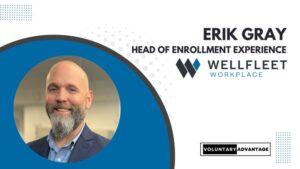
By Jim Foley
Vice-President, Product & Underwriting | Wellfleet Workplace
There’s been a sea change in voluntary benefits with insurance carrier solutions being more closely aligned to clients’ benefits, technology and process needs. So how do group underwriters chart these new waters? Alignment of insurance solutions to the customer through better client understanding using adaptable technology solutions and predictive modelling.
Voluntary Benefits Underwriting – A Look Back
Since starting in this industry over 20 years ago, much has changed. Back then, most aspects of the product offering were standard, from plan designs to administration. Employees within employer groups received individual policies with limited product options and everyone who was insured in a particular state received the same rates within certain classes! Even commissions were standard, typically heaped using predefined commission tables regardless of enrollment scenario.
The most notable difference for voluntary benefits underwriting is what goes into developing an underwriting offer. It used to be that offers were based on achieving a pre-set participation rate, with guarantee issue and individual underwriting criteria being established and enforced at the time of enrollment. The underwriter’s goal was to align the risk profile to the rate offered vs. rate to risk. Carriers leveraged their own enrollment and administrative systems with no need to understand the functionality of the employer’s enrollment or administrative technology.
Although, things may have been simpler, they missed the mark when it came to customer-centricity. Sure, we were able to provide the products clients needed, but they weren’t overly flexible. With the growing need to align technology, the benefit plans and coverage options expanded to fit an expanding universe of external platforms.
Voluntary Benefits Underwriting Flexibility
Today, employers want unique benefit plan offerings to help retain and attract talent. Voluntary benefits insurance contracts have an increasing number of options that allow each group to choose the benefits and design that best fits their benefit needs. To meet this need, insurers have focused on identifying and creating underwriting offers aligned with the needs of the client.
Rates are now filed with flexibility to align more closely with the specific group level opportunity. Factors can include: expected participation rates, group size, demographics of the eligible population, dynamics of the expected enrolled population and utilization behaviors. Due to this shift, underwriters need strategies to leverage an increasing number of rate variables, while also being able to convey the impacts that different benefits and definitions may have on a group.
Voluntary Benefits Administration Systems
Employer’s benefit enrollment and administration systems can create challenges for voluntary benefit carriers. The platforms tend to have different capabilities to handle plan designs, rate structures, eligibility requirements, evidence of insurability (EIO) questions presented during enrollment, billing/reconciliation capabilities and state variations. System limitations on rate structures need to be considered due to the effort to implement voluntary products. That’s why it is important to understand the external enrollment and administration systems prior to quoting.
Carrier systems increasingly need to be more flexible to align benefits, rates, enrollment and billing structures. While the market still wants some of the benefits of the traditional voluntary market, it also demands the ability to leverage features of the traditional core employee benefits space. For instance, some groups want issue age rates, list billing, and heaped commissions; while others prefer attained-age rates, self-administered billing and level commissions. Ultimately, this means the carrier’s quoting and administrative system needs to be able to handle all the options requested and quoted.
The time is now for insurers to invest in aligning with enrollment and benefit administration technologies that ensure compatibility with the various client administration platforms. This comes down to the ability for data from multiple sources to be readily accessible and whether it’s a custom-built solution or an API “plug and play”.
As technologies improve, providers like Wellfleet Workplace who are digitally-forward thinking are bringing more value to the enrollment process. Knowing that no two clients are the same, Wellfleet is focused on delivering flexible, quality products and services that are able to support the implementation and processing of benefits on a variety of platforms. This capability enables streamlined onboarding for customers, while reducing the use of human intervention.
Technology to Empower the Underwriter
The future of voluntary underwriting is greater use of predictive modelling and artificial intelligence to anticipate employer/employee needs and carrier financial performance. LIMRA research shows that nearly nine in 10 financial services companies have or are exploring the use of big data analytics to streamline the automated underwriting processes. This is because currently most underwriters follow a very manual process, with much of their time spent collecting and entering information often multiple times and reviewing case submissions for accuracy. Ultimately, this leaves little time to deeply review pertinent data.
Automation is quickly reshaping the role of the underwriter into that of a data strategist. The adoption of automation technology helps to organize historical and real-time data streams from multiple sources. Success will hinge on carrier systems that easily integrate multiple external data sources with internal data, while also providing analytic capabilities. This supports the creation of data models that improve the underwriter’s ability to use real-time “plug and play” analytics to asses risk thresholds and dynamic decision-making frameworks to uncover trends through human and artificial intelligence programs. In the end, it allows underwriters to quickly gain dynamic insights for risk tolerance from the case specific data they input.
As patterns develop, decision-making frameworks (“if/then” scenarios) can be mapped out according to things like industry, customer type, risk tolerance, expense expectations and profitability. These decision processes are then automated, allowing for real time processing with more aggressive, risk-appropriate pricing. The final output is better decision-making, the winning of more business and the driving of profitable growth.
The Predictive Modelling Challenge
Implementing data science for automation and decision making isn’t easy, striking a balance between utilizing current system resources and tapping into vendor expertise to build out functionality. It involves building a strategy that: identifies key inputs, removes roadblocks, improves the customer experience and drives profitability.
These strategies have a reliance on partnerships with employers, brokers and vendors to provide the information and be willing to work with carriers like Wellfleet Workplace. At Wellfleet, we understand the unique needs of our broker partners and the clients they serve. Our customer-centric philosophy and investment in new technologies enables us to build the innovative products and services they desire.
There is no denying that this is where the industry is going and that often fortune favors the bold. If you’re with a customer-centric organization, and you’re open to both failing and learning fast, the return via efficiencies and growth potential is well worth the investment of time and resources.





